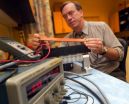Scientists reveal the sex wars of the truffle grounds
2010-10-26
(Press-News.org) They are one of the most highly prized delicacies in the culinary world, but now scientists have discovered that black truffles are locked in a gender war for reproduction. The research, published in New Phytologist as the truffle season begins, represents a breakthrough in the understanding of truffle cultivation and distribution.
The teams, led by Dr Francesco Paolocci and Dr Andrea Rubini from the CNR Plant Genetics Institute in Perugia and by Dr Francis Martin from INRA in Nancy, carried out their research on the reproduction strategy of the highly prized black truffle, Tuber melanosporum, which is grown across southern Europe. During the truffle season, between late autumn and winter, fruiting truffles can grow up to 7cm in diameter, weighing up to 100g with a value often measured in hundreds of Euros.
'Fruiting' is the crucial part of the truffle life cycle, occurring when the fungi interacts with and colonises host plants, usually at the roots. However, the process which causes this transition from vegetative to reproductive state remains unknown.
"It is commonly believed that truffles, like other fungi, are homothallic, meaning that they reproduce themselves," said Paolocci. "Because fungi that reproduce this way do not need a sexual partner it was believed that truffle cultivation relied only on the environment and nutrition, now we know that is wrong."
Taking advantage of the information provided by the T.melanosporum genome sequencing project led by Martin and from molecular analyses carried out by the Italian team, research now proves that truffles do outcross, meaning they are a two gender species, with sexual reproduction occurring between strains of opposite mating types.
The team studied samples of wild black truffle strains on plants from a natural truffle ground near Spoleto in central Italy. The study revealed that black truffle strains of opposite gender were not evenly distributed beneath potentially productive soil patches.
The team then studied the dynamics of truffle strains on host plants, artificially inoculated with truffle spores and grown in a greenhouse, which showed that a competition occurs between strains to colonise the host plant roots even under controlled conditions.
The truffle fruiting season traditionally begins in late autumn but sexual reproduction is believed to occur in spring. The Italian team demonstrated that during the latter season strain of opposite gender are present in the soil samples next to colonised host plants and that the host plant colonising strain acts as maternal partner in the reproductive process.
These findings represent a breakthrough in the understanding of truffle reproduction tactics as well as the dynamics of black truffle strains in both open-field conditions and on host plants produced to boost truffle production.
"These results are of considerable practical use for optimising and increasing production in truffle fields," concluded Paolocci. "It is of paramount interest to artificial truffle plantations to encourage a balance of strains of both mating types. Future investigations will allow us to determine whether the distribution of mating types is a factor that truly limits truffle fruiting body production."
INFORMATION: END
ELSE PRESS RELEASES FROM THIS DATE:
2010-10-26
Sleep disturbances increase the risk of work disability and may slow the return to work process. This is especially true in cases where work disability is due to mental disorders or musculoskeletal diseases. These results come from a recent study conducted by the Finnish Institute of Occupational Health in collaboration with the universities of Turku and London.
The research is being conducted as part of two major research projects on social capital in the workplace (Kunta10) and on well-being in the hospital workplace. The follow-up study is part of the Academy of Finland ...
2010-10-26
A child's chances of developing allergies or wheezing is related to how he or she grew at vital stages in the womb, according to scientists from the University of Southampton.
The new research, funded by the Medical Research Council (MRC) and the British Lung Foundation, and undertaken at Southampton General Hospital, reveals that fetuses which develop quickly in early pregnancy but falter later in pregnancy are likely to go on to develop allergies and asthma as children. Scientists believe this is due to changes in the development of their immune system and lungs.
A ...
2010-10-26
The field that these researchers are working in is known by its nickname, "anti-spoofing", and basically consists in trying to detect all of the possible attempts at fraud that a biometric system might suffer, especially with regard to an action in which the user presents the biometric proof to the system. "What we are trying to do is detect those attempts so that the system can then act accordingly", explains the head of UC3M's Grupo Universitario de Tecnologías de Identificación (GUTI)(University Identification Technology Group), Raúl Sánchez Reíllo, who is leading this ...
2010-10-26
Flamingos apply natural make-up to their feathers to stand out and attract mates, according to a new study by Juan Amat, from the Estación Biológica de Doňana in Seville, Spain, and colleagues. Their research is the first to demonstrate that birds transfer the color pigments (carotenoids) from the secretions of their uropygial gland for cosmetic reasons. The uropygial or preen gland is found in the majority of birds and is situated near the base of the tail. The study is published online in Behavioral Ecology and Sociobiology, a Springer journal.
There is evidence ...
2010-10-26
AUGUSTA, Ga. - A daily dose of whole body vibration may help reduce the usual bone density loss that occurs with age, Medical College of Georgia researchers report.
Twelve weeks of daily, 30-minute sessions in 18-month old male mice – which equate to 55- to 65-year-old humans – appear to forestall the expected annual loss that can result in fractures, disability and death. Dr. Karl H. Wenger, biomedical engineer in the MCG Schools of Graduate Studies and Medicine, reported the findings with his colleagues in the journal Bone.
Researchers found vibration improved density ...
2010-10-26
A popular cancer drug could be produced cheaply and sustainably using stem cells derived from trees, a study suggests.
Researchers have isolated and grown stem cells from a yew tree whose bark is a natural source of the anticancer compound paclitaxel. The development could enable the compound to be produced on a commercial scale at low cost, with no harmful by-products.
Scientists and engineers behind the development say the drug treatment – currently used on lung, ovarian, breast, head and neck cancer – could become cheaper and more widely available.
The study was ...
2010-10-26
Patients with cancer found at the end of the large intestine called the rectum who receive one week of radiation therapy before surgery have a 50 percent reduction in chance that their cancer will return after 10 years, according to a large, randomized study presented at the plenary session, November 1, 2010, at the 52nd Annual Meeting of the American Society for Radiation Oncology (ASTRO).
"We believe that this short course of radiation will open a new window of opportunities in the treatment of rectal cancer," Corrie Marijnen M.D., lead author of the study and a radiation ...
2010-10-26
Men with prostate cancer who take anticoagulants like aspirin in addition to radiation therapy or surgery may be able to cut their risk of dying of the disease by more than half, according to a large study presented on November 3, 2010, at the 52nd Annual Meeting of the American Society for Radiation Oncology (ASTRO) in San Diego. The study involved more than 5,000 men with localized cancer whose disease had not spread beyond the prostate gland.
"Evidence has shown that anticoagulants may interfere with cancer growth and spread," Kevin Choe, M.D., Ph.D., lead author of ...
2010-10-26
Men treated for prostate cancer who were diagnosed after the start of routine screening had a significantly reduced risk of the disease spreading to other parts of the body (metastases) within 10 years of treatment, compared to men who were treated prior to the use of routine screening, according to the first study-of-its-kind presented November 1, 2010, at the 52nd Annual Meeting of the American Society for Radiation Oncology (ASTRO).
In 1993, routine prostate cancer screening became widely implemented through the use of a prostate specific antigen (PSA) test that was ...
2010-10-26
Prostate cancer patients who are treated with a combination of hormone therapy and radiation have a substantially improved chance of survival compared to patients who do not receive radiation, according to interim results of the largest randomized study of its kind presented at the plenary session, November 1, 2010, at the 52nd Annual Meeting of the American Society for Radiation Oncology (ASTRO).
From 1995 to 2005, 1,205 men with high-risk prostate cancer in the United States, the United Kingdom and Canada were randomly selected to receive hormone therapy alone or a ...
LAST 30 PRESS RELEASES:
[Press-News.org] Scientists reveal the sex wars of the truffle grounds

